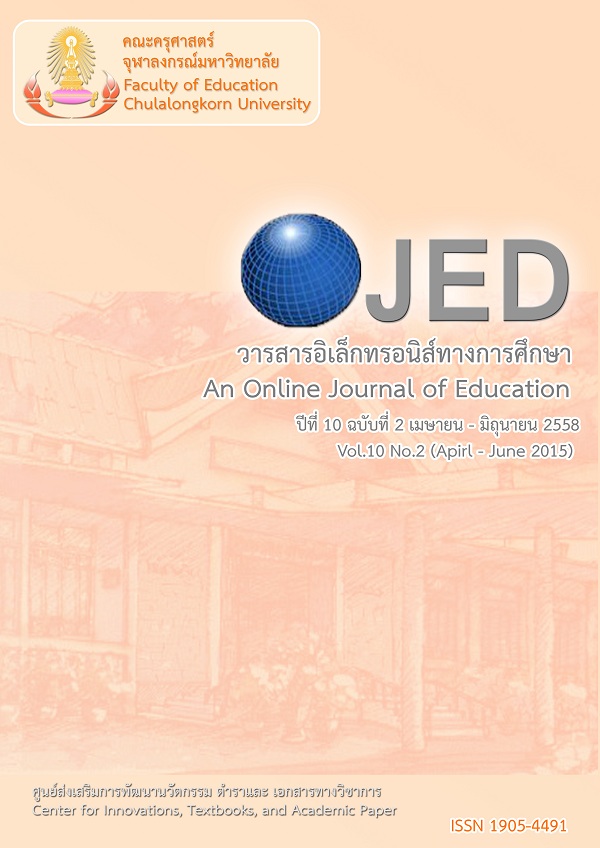การพัฒนาบทเรียนเปียโนสาหรับนักเรียนระดับพื้นฐานถึงระดับกลาง โดยใช้การเรียบเรียงดนตรีพื้นบ้านไทย
คำสำคัญ:
ดนตรีพื้นบ้านไทย, เปียโน, THAI FOLK MUSIC, PIANOบทคัดย่อ
การวิจัยครั้งนี้มีวัตถุประสงค์เพื่อ 1) ศึกษาแนวทางการคัดเลือกและเรียบเรียงดนตรีพื้นบ้านสาหรับการบรรเลงเปียโนและ 2) นาเสนอบทเรียนที่เรียบเรียงจากดนตรีพื้นบ้านไทยสาหรับการเรียนการสอนวิชาทักษะเปียโนในระดับพื้นฐานถึงระดับกลาง ศึกษาจากกลุ่มตัวอย่างดังนี้ 1) สาระและทักษะเปียโนระดับขั้นพื้นฐานถึงระดับกลางของสถาบันสอบเปียโน จานวน 3 สถาบัน 2) บทเรียนสาหรับเปียโนที่เรียบจากดนตรีพื้นบ้าน 3) ผู้เชี่ยวชาญทางด้านดนตรีพื้นบ้าน และ4) ดนตรีพื้นบ้าน 4 ภาคของประเทศไทย ได้แก่ ภาคเหนือ ภาคตะวันออกเฉียงเหนือ ภาคกลาง และภาคใต้ เครื่องมือที่ใช้ในการวิจัยได้แก่ 1) แบบบันทึกและวิเคราะห์สาระทักษะการบรรเลงเปียโนจากบทเพลงสอบในระดับขั้นพื้นฐานถึงระดับกลาง 2) แบบบันทึกและวิเคราะห์บทเรียนที่เรียบเรียงจากดนตรีพื้นบ้านสาหรับเปียโน 3) แบบสัมภาษณ์ผู้เชี่ยวชาญทางด้านดนตรีพื้นบ้าน และ 4) แบบบันทึกและวิเคราะห์ทานองเพลงดนตรีพื้นบ้านของประเทศไทย
ผลการวิจัยพบว่า แนวทางการคัดเลือกและเรียบเรียงดนตรีพื้นบ้านสาหรับการบรรเลงเปียโนในแต่ละระดับ แบ่งออกเป็น 3 ขั้นตอน ขั้นที่ 1 สาระเนื้อหาของสาระดนตรีและการบรรเลงเปียโนที่เป็นตัวชี้วัดของแต่ละระดับ ประกอบด้วยด้านเทคนิคการบรรเลงเปียโนและด้านสาระดนตรีและความเป็นดนตรี ขั้นที่ 2 คัดเลือกทานองเพลงดนตรีพื้นบ้านสาหรับการบรรเลงเปียโนจะคัดเลือกทานองเพลงที่มีองค์ประกอบดนตรีที่สามารถนาไปเรียบเรียงและพัฒนาเป็นบทเรียนได้ในแต่ละระดับอย่างเหมาะสมและบทเพลงยังมีความหมายของเนื้อหาที่แสดงถึงวัฒนธรรม ประเพณีหรือวิถีชีวิตของชุมชนในภูมิภาค ขั้นที่ 3 เรียบเรียงทานองเพลงดนตรีพื้นบ้านไทยสาหรับการเรียนการสอนวิชาทักษะเปียโนในระดับพื้นฐานถึงระดับกลางโดยคานึงถึงองค์ประกอบดังนี้ 1) สาระดนตรีจากตัวชี้วัดที่กาหนดในแต่ละระดับเพื่อให้เนื้อหาบทเรียน ครอบคลุมและครบถ้วนทั้งด้านเทคนิคการบรรเลงและสาระดนตรี และ 2) ลักษณะเฉพาะทางดนตรีของทานองเพลงพื้นบ้านแต่ละภูมิภาค
The repertoires of piano curriculum are normally based on musical elements and techniques of various music genres, ranging from music for Baroque era to the present. Folk music is a particular type of music in piano curriculum. Arranging of folk music has also become part of repertoires. According to the music teaching concept the use of national folk music help music learners to understand music of their own culture faster than that of other cultures. Bartok for instance, arranged Mikrokosmos from Hungarian and neighboring countries folk music for piano. Yet, Thai folk music is rarely arranged and used for piano lessons. This study aims to developed guideline for selecting and arranging Thai folk music for piano lessons in elementary to intermediate levels. The research tools used in the study include tally sheets for analysis musical contents in piano pieces in elementary to intermediate levels selected from international piano examination boards and tally sheets for analysis Thai folk music from four areas in Thailand; the Northern area, the Northeastern area, the Center area, and the Southern area. Thai folk music is selected via suggestion of Thai folk music specialists. Subsequently, the guideline for piano lessons using the arrangement of Thai folk music is developed in accordance with Bartok’s Mikrokosmos.
The result was as followed; a guideline for selecting and arranging Thai folk music in elementary to intermediate piano levels should be focusing on three domains: 1) melody, 2) rhythmic patterns, and 3) musical harmony. In addition social culture context in each region should also be taken into consideration. According to the study, the guideline can be adapted for arranging in different musical instruments. Moreover, the arrangements help to promote Thai folk music context in different cultures and it can be a way of cultural preservation by adapting into a contemporary style.




